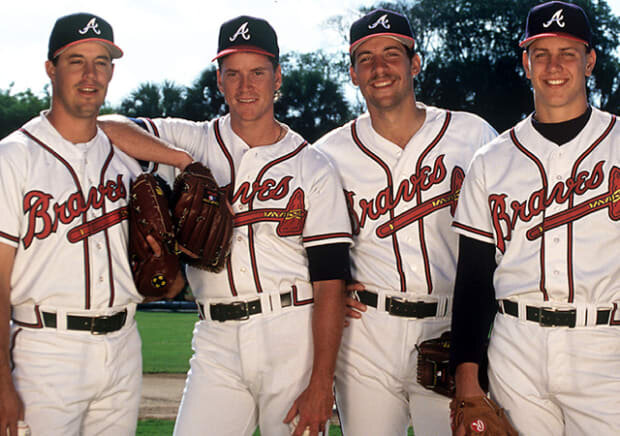Is a 90’s Braves Rotation Likely in Today's MLB?
Last fall while watching the 2019 World Series, I found myself being far more engaged with the matchup between the Houston Astros and the Washington Nationals compared to previous years. The 2019 World Series featured veteran star-driven starting pitchers Justin Verlander, Gerrit Cole, Zach Greinke, Patrick Corbin, and Stephen Strasburg, all who accumulated at least 200 innings pitched during the regular season. Three-time Cy Young Award Winner and ace Max Schzerer would have made six if not battling a neck issue during the year.
The last time we saw at least five pitchers meet in the World Series, all who had logged over 200 innings during the regular season, was when the Houston Astros faced the Chicago White Sox in the 2005 World Series. So what’s the significance of 200 innings?
As the game of baseball continues to advance into a game fueled by data, analytics, technology, and shifts to newly accepted measures of predictive performance, maybe the value of a pitcher being able to eclipse 200 innings has significant value to future performance?
Anchors of the 1990’s Atlanta Braves pitching staff. Pictured left to right, Greg Maddux, Tom Glavine, John Smoltz, and Steve Avery.
From 1991 to 2001, the Atlanta Braves had 3 or more starting pitchers eclipse 200 innings pitched in 9 out of the 11 seasons. The two seasons they fell short were only because of the MLB Strike which shortened the 1994 and 1995 seasons. During this same period, the Atlanta Braves finished 1st in the NL East every year allowing them to reach the postseason each year and they went on to five World Series in eight years. The combination of just seven starting pitchers, Tom Glavine, John Smoltz, Steve Avery, Greg Maddux, Charlie Leibrandt, Denny Neagle, and Kevin Millwood helped to solidify a successful winning MLB Organization for over a decade.
Since 2015, only 3 teams finished the regular season with 3 or more starting pitchers to finish the season with 200+ innings pitched. As we look back over the last thirty years of the World Series, the number of starting pitchers in a World Series to have accumulated 200+ innings pitched during the regular season continues to shrink with each decade.
Figure 1: The average total number of starting pitchers in a World Series to accumulate over 200 IP during a regular season has declined the last 3 decades from 4.7 (1988 to 1999) to 4.2 (2000 to 2009) to 2.7 (2010 to 2019).
However, Major League Baseball seems to be pivoting from the traditional workhouse starting pitcher to "openers" or starters whose job description may entail, "get the team through 5 innings, twice through the lineup, and let the bullpen take it from there." With increasingly more high-velocity relievers paired with an emphasis on the strikeout, the building of a pitching staff at the MLB level is changing. But, Is the change necessarily a positive shift for MLB Organizations in terms of winning?
Figure 2
Looking at Figure 2, since 2015, the Nationals, Astros, Indians, and RedSox had at least 5 starting pitchers with 200 innings pitched and have reached or won a World Series. There may be a variety of ways to build a competitive MLB team on a year to year basis, but to achieve success over a decade at the MLB Level, depth at starting pitching, especially the traditional workhouse, is a proven formula across the history of the game.
From 1993 to 2002, a combination of Greg Maddux, Tom Glavine, and John Smoltz combined to throw over 6000 innings helping the Atlanta Braves become one of the most successful MLB franchises in baseball history. The likelihood of three Hall of Fame pitchers pitching on the same team for 10 consecutive seasons is highly unlikely but in today’s game, is it possible for an MLB Organization to engineer or develop a starting rotation that has the potential to produce the consistent starting pitching that not only stabilizes a franchise but builds a culture of winning across a decade? Wouldn’t it be beneficial for year after year to have three or more starting pitchers become household names in their respective cities, build fan loyalty, and increase their chances of reaching the pinnacle of their sport, the World Series? Not to mention the financial benefits.
In our previous article, From the Check Engine Light to the Check Elbow Light we mentioned that in the last five years, MLB teams have paid over $1.7B to pitchers while they were on the injured list. In 2019 alone, over 22,000 days were spent on the injured list by pitchers. In terms of seasons, this is equivalent to the complete pitching staff of 10 MLB teams, a third of the league, missing the entire season. This statistic makes it extremely difficult for MLB Organizations to build consistency within their pitching staff. The influx of injuries has a trickle effect throughout the entire organization and the revolving door of pitchers moving up and down to suffice the injury issue is not appealing to fans or the virtue of the game.
The 2019 World Series may have showcased a dying breed of the workhorse starting pitcher. As we look to the next wave of young starters to carry the torch, 2020 has not been kind. This year alone, we have already seen star pitchers Noah Syndergaard, Chris Sale and Luis Severino succumb to Tommy John surgery. As the 2020 MLB Season sits idle and indefinitely postponed due to COVID-19, no pitchers will likely reach the 200 IP milestone. But, as the game looks ahead to 2021 and beyond, maybe a MLB Team or two, can produce and develop a fraction of what the 1990’s Braves starting rotation achieved.


